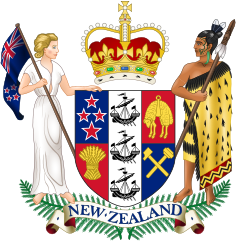Coat of arms of New Zealand
| Coat of arms of New Zealand | |
|---|---|
 | |
| Versions | |
 1911–1956 | |
Silver fern leaves | |
| Motto | "New Zealand"[2] |
The coat of arms of New Zealand (
The arms were granted by warrant of
History
Until 1911, New Zealand used the same

With the evolution of New Zealand
The central shield has remained unaltered since 1911. It comprises a quartered shield containing in the first quarter four stars representing the
1956 redesign
In the original design, the crest was a
Although the royal warrant specified the design of the coat of arms, by the mid-1940s at least 20 variants were in use.
Queen Elizabeth II approved a revised version in 1956; she also expressly authorised the use of the St Edward's Crown in the arms.[9] That design is still in use today.[2]
Symbolism

The coat of arms depicts a shield with four quadrants divided by a central pale:[6]
- The first quadrant depicts the four stars on the national flag, representing the asterism within the constellation of Crux; the second quadrant depicts a golden fleece, representing the nation's farming industry; the third depicts a sheaf of wheat for agriculture; and the fourth quadrant depicts crossed hammers for mining.
- The pale depicts three ships, representing the importance of sea trade, and the immigrant nature of all New Zealanders.
- The kaitaka(flax cloak).
- The female figure is said to be a depiction of Zealandia, a common national personification of New Zealand during the first half of the 20th century. It also broadly represents all "non-indigenous citizens of the country".[6]
- The shield is surmounted by a rendition of St Edward's Crown, which has been used in the coronations of New Zealand's monarchs. The Crown also represents New Zealand's historic ties to the United Kingdom.
- Below is a scroll with "New Zealand" on it, behind which (constituting the "heraldic compartment" on which the supporters stand) are two fernbranches, representing the native vegetation.
Status and uses

None of New Zealand's national symbols—including the flag, the anthems, and coat of arms—are mentioned in the Constitution Act 1986. The official use of the coat of arms was mandated by royal warrant in 1911.[5] The use of state, royal, and viceregal emblems is also protected by the Flags, Emblems, and Names Protection Act 1981.[10]
The arms are a symbol of national sovereignty. As such, official usage of the coat of arms is restricted to the
Since 1962, a
On a few special occasions, such as royal visits or jubilee celebrations, individuals and private organisations can display the coat of arms temporarily. It can only be used or published with the permission of the Ministry for Culture and Heritage.[2]
See also
- Flag of New Zealand
- Seal of New Zealand, used to authorise official instruments of government
- Queen's Personal New Zealand Flag
- New Zealand heraldry
References
- ^ a b c "New Zealand Coat of Arms" (PDF). The New Zealand Gazette. 11 January 1912. p. 52.
- ^ a b c d "Coat of Arms". www.mch.govt.nz. Ministry for Culture and Heritage. Retrieved 23 August 2017.
- ^ Wilson, John (16 September 2016). "Tuakiri o Aotearoa me te kāwanatanga - Te tuakiri o Aotearoa" (in Māori). Te Ara: The Encyclopedia of New Zealand. Retrieved 14 July 2019.
- ^ a b "National Arms of New Zealand". www.ngw.nl. Heraldry of the World. Retrieved 23 August 2017.
- ^ a b "New Zealand Coat of Arms warranted". Ministry for Culture and Heritage. 27 July 2017. Retrieved 23 August 2017.
- ^ a b c Levine, Stephen (20 June 2012). "Coat of arms - Coat of arms overview". Te Ara: The Encyclopedia of New Zealand.
- ^ "New Zealand Coat of Arms 1911-1956'". Ministry for Culture and Heritage. 20 December 2012. Retrieved 23 August 2017.
- ^ ISBN 978-1-877347-37-5. Archived from the originalon 10 April 2017.
- ^ "Royal approval for revised coat of arms". Retrieved 2 March 2022 – via Te Ara: The Encyclopedia of New Zealand.
In 1956 the New Zealand government agreed to revise the 1911 coat of arms. Queen Elizabeth II approved the changes and initialled both the letter sent to her by New Zealand Prime Minister Sidney Holland and the new version of the coat of arms.
- ^ a b "Flags, Emblems, and Names Protection Act 1981 No 47 (as at 03 June 2017), Public Act Contents". www.legislation.govt.nz. Parliamentary Counsel Office. Retrieved 23 August 2017.
- ^ Levine, Stephen. "Coat of arms, Supreme Court building, Wellington – Coat of arms". Te Ara: The Encyclopedia of New Zealand. Retrieved 23 August 2017.
- ^ Levine, Stephen. "New Zealand passport – Coat of arms". Te Ara: The Encyclopedia of New Zealand. Retrieved 23 August 2017.
- ^ "Other flags". Ministry for Culture and Heritage. Retrieved 23 January 2019.
- ^ "The Governor-General's Flag". Government House. Retrieved 21 June 2018.
External links
- A National Symbol?, by Denis Glover, about Zealandia, Britannia's daughter: the woman symbolising New Zealand. 1966 Encyclopaedia of New Zealand
- legislation.govt.nz – Flags, Emblems, and Names Protection Act 1981
- National Arms of New Zealand (with history and images), at Heraldry of the World
